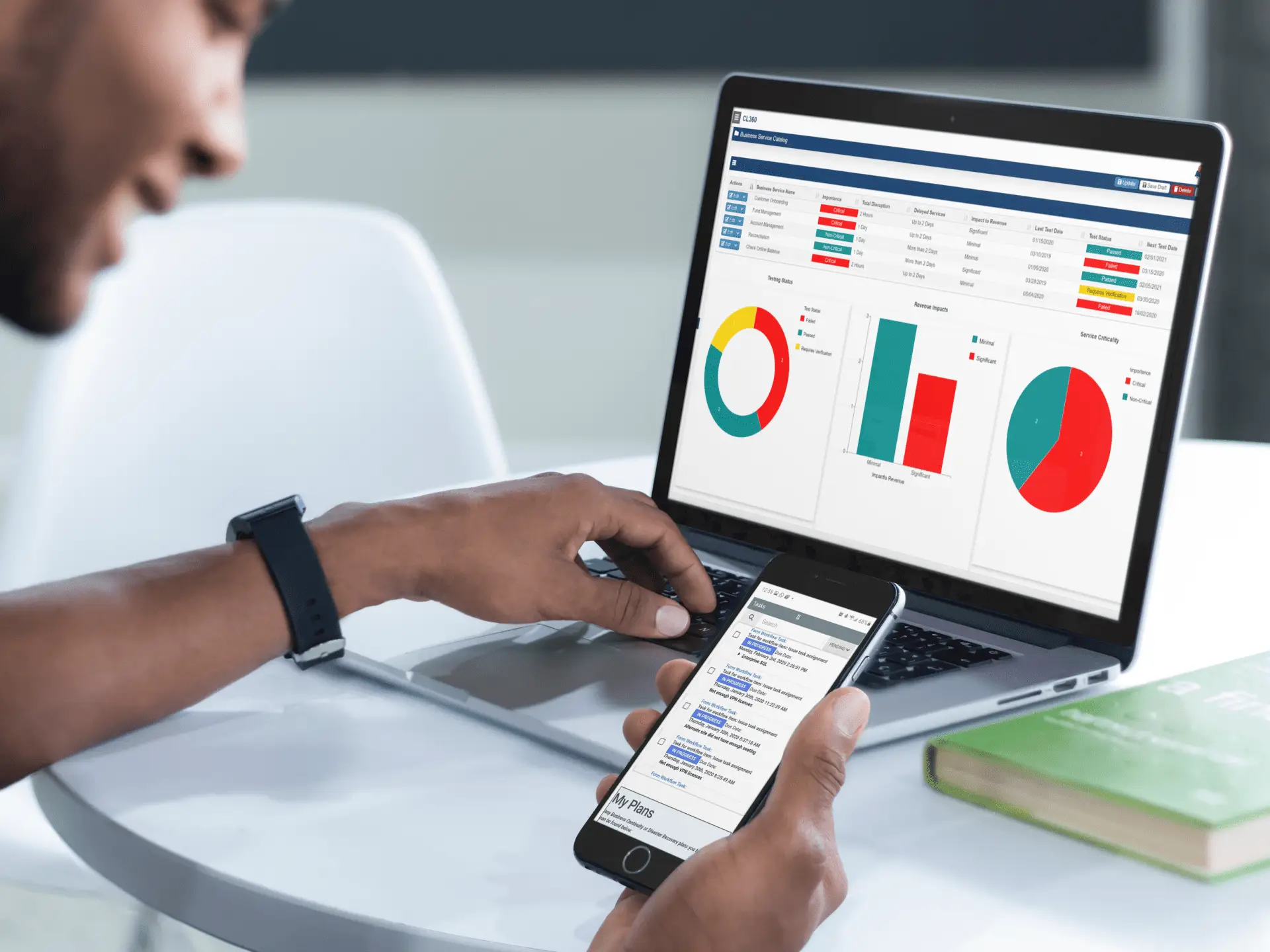In the modern business landscape, digital platforms have become the backbone of operations, driving efficiency, scalability, and innovation. As organizations increasingly rely on these platforms, the need for robust operational resilience and business continuity software has never been more pronounced. At CLDigital, we understand the intricacies of this digital shift and the importance of ensuring uninterrupted operations. With the CL360 platform, businesses are equipped to navigate the complexities of the digital age, ensuring they remain resilient in the face of challenges.
The Digital Age and Its Challenges
The Shift to Digital Platforms
The last decade has witnessed a monumental shift in the way businesses operate. Traditional brick-and-mortar models have given way to digital-first strategies, with companies leveraging online platforms to reach global audiences, streamline operations, and innovate at unprecedented speeds. The CL360 platform, with its no-code development and analytics capabilities, has been at the forefront of this transformation, empowering businesses to adapt and thrive. However, as with any significant change, the move to digital platforms comes with its set of challenges. From cybersecurity threats to system downtimes, businesses are constantly navigating a myriad of potential disruptions.
Unforeseen Challenges in the Digital Landscape
The digital realm, while offering boundless opportunities, is not without its pitfalls. Common disruptions businesses face include:
- Cybersecurity breaches: With increasing amounts of data being stored and processed online, businesses are attractive targets for cybercriminals. The CL360 platform’s security features ensure that data remains protected against such threats.
- System outages: Downtimes can result in significant revenue losses and damage to brand reputation. Ensuring robust hosting and data integration, as offered by CL360, is crucial.
- Regulatory changes: As the digital landscape evolves, so do the regulations governing it. Staying compliant requires constant vigilance and adaptability.
- Rapid technological advancements: Keeping up with the pace of technological change can be daunting. Businesses need platforms like CL360 that are flexible and can easily integrate with emerging technologies.
The cost of unpreparedness in the face of these challenges can be staggering. From lost revenues and legal penalties to eroded customer trust, businesses that fail to prioritize operational resilience and business continuity find themselves at a significant disadvantage.
Understanding Operational Resilience Software
What is Operational Resilience?
Operational resilience refers to an organization’s ability to continue delivering critical operations throughout disruptions. It’s not just about bouncing back after a disruption but proactively identifying potential vulnerabilities and addressing them before they escalate. In the age of digital transformation, where businesses are increasingly dependent on interconnected systems, operational resilience has become paramount.
Unlike traditional risk management, which often focuses on financial risks and reactive measures, operational resilience is holistic. It encompasses a wide range of potential disruptions, from cyberattacks to natural disasters, and emphasizes proactive measures. The goal is not just to manage risks but to adapt and evolve in the face of them. With platforms like CL360, businesses can harness the power of operational resilience software to navigate these challenges effectively.
Features and Benefits of Operational Resilience Software
Operational resilience software, like the CL360 platform, offers a suite of features designed to bolster an organization’s defense against disruptions. Some key functionalities include:
- No-Code Development: Allows businesses to customize and adapt their operational strategies without the need for extensive coding knowledge.
- Data Integrations: Ensures that all data sources are interconnected, providing a holistic view of potential vulnerabilities.
- Configurable Document Design: Tailors documentation to specific organizational needs, ensuring clarity and consistency in resilience strategies.
- Analytics: Provides insights into operational performance, highlighting areas of strength and potential vulnerabilities.
The real-world applications of operational resilience software are vast. For instance, during a cyberattack, the software can identify the breach, isolate affected systems, and initiate recovery protocols, all while ensuring that critical operations continue unhindered. Similarly, in the face of a natural disaster, the software can reroute operations to unaffected areas, ensuring continuity.
Case studies, such as those involving CL360, have showcased the tangible benefits of operational resilience software. Businesses that have implemented such solutions have reported reduced downtimes, minimized financial losses, and enhanced stakeholder trust.

Business Continuity Software: The Reactive Shield
Defining Business Continuity
Business continuity is the strategic and reactive approach that organizations adopt to ensure that essential functions can continue during and after a disaster or disruption. It’s the blueprint that guides an organization on how to stay on its feet and recover after unforeseen events. In essence, while operational resilience is about building a robust system that can withstand disruptions, business continuity is about having a plan in place when those disruptions occur.
In the digital age, where operations are deeply intertwined with technology, the importance of business continuity has magnified. A single hour of downtime can result in significant financial losses, not to mention the potential damage to brand reputation and customer trust. With platforms like CL360, businesses can seamlessly integrate business continuity plans into their operational fabric, ensuring they are always prepared.
How Business Continuity Software Complements Operational Resilience
Operational resilience and business continuity, while distinct, are two sides of the same coin. Business continuity software, like the solutions integrated into the CL360 platform, offers features that complement operational resilience:
- Scenario Planning: Allows businesses to simulate various disruption scenarios and test their preparedness.
- Automated Response Protocols: In the event of a disruption, the software can automatically initiate recovery measures, minimizing downtime.
- Real-time Communication Tools: Ensures stakeholders are kept in the loop during disruptions, fostering transparency and trust.
- Data Backup and Recovery: Safeguards critical data, ensuring it can be recovered post-disruption.
The synergy between operational resilience and business continuity software has been evident in numerous case studies. For instance, companies that faced significant cyberattacks were able to minimize operational impact by leveraging the combined strengths of both tools. Their operational resilience measures identified and isolated the threat, while their business continuity plans ensured that operations could continue unhindered.
Integrating Both for Comprehensive Protection
Working in Tandem: Strengths of Both Tools
Operational resilience and business continuity, while distinct in their approaches, are most effective when used in conjunction. Together, they form a comprehensive shield against disruptions, ensuring that businesses not only withstand challenges but also recover swiftly.
- Proactive and Reactive Measures: While operational resilience focuses on proactively identifying and mitigating potential threats, business continuity offers a reactive plan to ensure operations continue post-disruption. This dual approach ensures that businesses are always one step ahead.
- Data Protection and Recovery: Operational resilience tools, like those in the CL360 platform, safeguard against data breaches, while business continuity ensures that, in the event of data loss, recovery mechanisms are in place.
- Continuous Operations: With both tools in place, businesses can ensure that operations continue seamlessly, even in the face of significant disruptions. This not only safeguards revenues but also protects brand reputation.
The benefits of a combined approach are manifold. From reduced downtimes and financial losses to enhanced stakeholder trust, businesses that integrate both operational resilience and business continuity are better positioned to navigate the challenges of the digital age.
Steps to Implementing a Dual Strategy
Successfully integrating both operational resilience and business continuity requires a strategic approach. Here are some best practices and tips:
- Assessment: Begin by assessing the current state of your operational resilience and business continuity measures. Identify gaps and areas of improvement.
- Customization: Tools like the CL360 platform offer no-code development, allowing businesses to tailor solutions to their unique needs.
- Regular Testing: Simulate disruptions to test the effectiveness of your measures. This not only identifies potential weaknesses but also trains staff on how to respond during actual disruptions.
- Stakeholder Communication: Ensure that all stakeholders, from employees to partners, are aware of the measures in place. Regular communication fosters trust and ensures everyone is on the same page.
- Continuous Improvement: The digital landscape is ever-evolving. Regularly update and refine your strategies to stay ahead of potential threats.
By following these steps and leveraging platforms like CL360, businesses can harness the combined strengths of operational resilience and business continuity, ensuring they are well-equipped to face the challenges of the digital age.

Embracing Resilience and Continuity in the Digital Era
The digital age, with its myriad of opportunities, also brings forth unprecedented challenges. As businesses increasingly rely on digital platforms, the importance of ensuring uninterrupted operations cannot be overstated. Operational resilience, with its proactive approach, equips businesses to identify and mitigate potential threats. On the other hand, business continuity provides a reactive blueprint, guiding organizations on how to recover and continue operations post-disruption.
Platforms like CL360 have showcased the tangible benefits of integrating both operational resilience and business continuity. From reduced downtimes and safeguarded revenues to enhanced stakeholder trust, the advantages are manifold.
As we navigate the complexities of the digital landscape, it’s imperative for businesses to adopt a holistic approach. By harnessing the combined strengths of operational resilience and business continuity, organizations can not only withstand challenges but also thrive amidst them. In this ever-evolving digital era, being prepared is not just an advantage; it’s a necessity.



